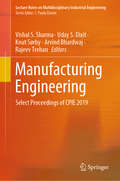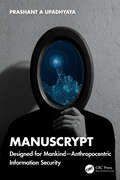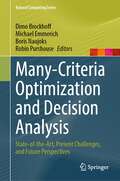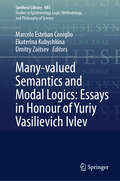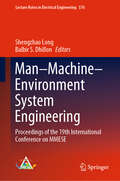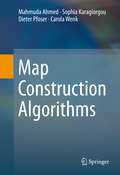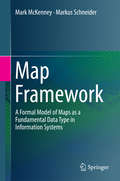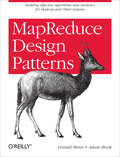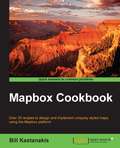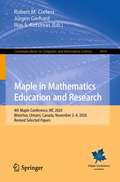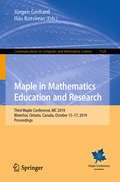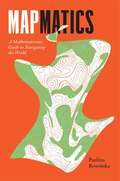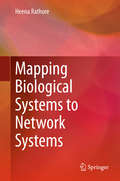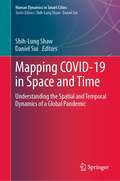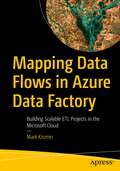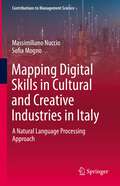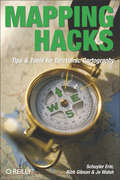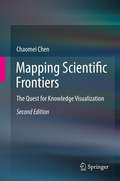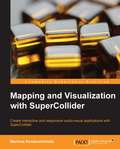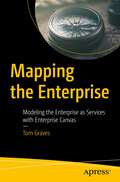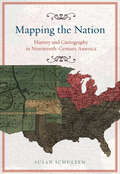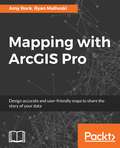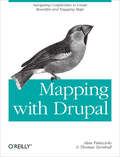- Table View
- List View
Manufacturing Engineering: Select Proceedings of CPIE 2019 (Lecture Notes on Multidisciplinary Industrial Engineering)
by Uday S. Dixit Vishal S. Sharma Knut Sørby Arvind Bhardwaj Rajeev TrehanThis volume comprises select peer-reviewed contributions from the International Conference on Production and Industrial Engineering (CPIE) 2019. The contents focus on latest research in production and manufacturing engineering including case studies with analytical models and latest numerical approaches. The topics covered include micro, nano, and non-conventional machining, additive manufacturing, casting and forming, joining processes, vibrations and acoustics, materials and processing, product design and development, industrial automation, CAD/CAM and robotics, and sustainability in manufacturing. The book can be useful for students, researchers, and professionals working in manufacturing and production engineering, and other allied fields.
ManusCrypt: Designed for Mankind – Anthropocentric Information Security
by Prashant A UpadhyayaInformation security primarily serves these six distinct purposes—authentication, authorization, prevention of data theft, sensitive data safety / privacy, data protection / integrity, non-repudiation. The entire gamut of infosec rests upon cryptography. The author begins as a protagonist to explain that modern cryptography is more suited for machines rather than humans. This is explained through a brief history of ciphers and their evolution into cryptography and its various forms. The premise is further reinforced by a critical assessment of algorithm-based modern cryptography in the age of emerging technologies like artificial intelligence and blockchain. With simple and lucid examples, the author demonstrates that the hypothetical "man versus machine" scenario is not by chance, but by design. The book doesn’t end here like most others that wind up with a sermon on ethics and eventual merging of humans with technology (i.e., singularity). A very much practicable solution has been presented with a real-world use-case scenario, wherein infosec is designed around the needs, biases, flaws and skills of humans. This innovative approach, as trivial as it may seem to some, has the power to bring about a paradigm shift in the overall strategy of information technology that can change our world for the better.
Many-Criteria Optimization and Decision Analysis: State-of-the-Art, Present Challenges, and Future Perspectives (Natural Computing Series)
by Michael Emmerich Boris Naujoks Robin Purshouse Dimo BrockhoffThis book presents the state-of-the-art, current challenges, and future perspectives for the field of many-criteria optimization and decision analysis. The field recognizes that real-life problems often involve trying to balance a multiplicity of considerations simultaneously – such as performance, cost, risk, sustainability, and quality. The field develops theory, methods and tools that can support decision makers in finding appropriate solutions when faced with many (typically more than three) such criteria at the same time. The book consists of two parts: key research topics, and emerging topics. Part I begins with a general introduction to many-criteria optimization, perspectives from research leaders in real-world problems, and a contemporary survey of the attributes of problems of this kind. This part continues with chapters on fundamental aspects of many-criteria optimization, namely on order relations, quality measures, benchmarking, visualization, and theoretical considerations. Part II offers more specialized chapters on correlated objectives, heterogeneous objectives, Bayesian optimization, and game theory. Written by leading experts across the field of many-criteria optimization, this book will be an essential resource for researchers in the fields of evolutionary computing, operations research, multiobjective optimization, and decision science.
Many-valued Semantics and Modal Logics: Essays in Honour of Yuriy Vasilievich Ivlev (Synthese Library #485)
by Marcelo Esteban Coniglio Dmitry Zaitsev Ekaterina KubyshkinaThis volume is a collection of essays related to the work of Professor Yuriy Vasilievich Ivlev, a distinguished Russian logician and philosopher renowned for his expertise in many-valued and modal logics. Notably, his groundbreaking work on quasi-matrices for logics, now recognized as non-deterministic matrices and non-deterministic semantics, emerged in the 1970s. From a philosophical standpoint, Ivlev’s research delves into the formal analysis of indeterminacy, offering a logical framework to understand how sequences of indeterminate events can yield determinate outcomes. The volume follows two complementary lines of research. Firstly, it serves as a platform for the exploration and discussion of Ivlev’s seminal contributions to the algebraic characterization of both normal and non-normal modal logics, aimed at making these insights accessible to an international audience. Secondly, it features contributions from esteemed logicians and philosophers worldwide, offering diverseperspectives on the logical analysis of indeterminacy. This comprehensive volume will appeal to scholars and researchers in logic, philosophy, and mathematics who are engaged in the study of many-valued and modal methodologies for modeling situations of indeterminacy.
Man–Machine–Environment System Engineering: Proceedings of the 19th International Conference on MMESE (Lecture Notes in Electrical Engineering #576)
by Balbir S. Dhillon Shengzhao LongThese proceedings showcase the best papers selected from more than 500 submissions, and introduce readers to the latest research topics and developmental trends in the theory and application of MMESE. The integrated research topic Man–Machine–Environment System Engineering (MMESE) was first established in China by Professor Shengzhao Long in 1981, with direct support from one of the greatest modern Chinese scientists, Xuesen Qian. In a letter to Long from October 22nd, 1993, Qian wrote: “You have created a very important modern science and technology in China!”MMESE studies the optimum combination of man–machine–environment systems. In this system, “man” refers to the people in the workplace (e.g. operators, decision-makers); “machine” is the general name for any object controlled by man (including tools, machinery, computers, systems and technologies), and “environment” describes the specific working conditions under which man and machine interact (e.g. temperature, noise, vibration, hazardous gases, etc.). The three main goals of optimizing man–machine–environment systems are to ensure safety, efficiency and economy.These proceedings present interdisciplinary studies on concepts and methods from physiology, psychology, system engineering, computer science, environmental science, management, education, and other related disciplines. They offer a valuable resource for all researchers and professionals whose work involves interdisciplinary areas touching on MMESE subjects.
Map Construction Algorithms
by Mahmuda Ahmed Sophia Karagiorgou Dieter Pfoser Carola WenkThe book provides an overview of the state-of-the-art of map construction algorithms, which use tracking data in the form of trajectories to generate vector maps. The most common trajectory type is GPS-based trajectories. It introduces three emerging algorithmic categories, outlines their general algorithmic ideas, and discusses three representative algorithms in greater detail. To quantify map construction algorithms, the authors include specific datasets and evaluation measures. The datasets, source code of map construction algorithms and evaluation measures are publicly available on http://www. mapconstruction. org. The web site serves as a repository for map construction data and algorithms and researchers can contribute by uploading their own code and benchmark data. Map Construction Algorithms is an excellent resource for professionals working in computational geometry, spatial databases, and GIS. Advanced-level students studying computer science, geography and mathematics will also find this book a useful tool.
Map Framework
by Markus Schneider Mark MckenneyThis book explores the concept of a map as a fundamental data type. It defines maps at three levels. The first is an abstract level, in which mathematic concepts are leveraged to precisely explain maps and operational semantics. The second is at a discrete level, in which graph theory is used to create a data model with the goal of implementation in computer systems. Finally, maps are examined at an implementation level, in which the authors discuss the implementation of a fundamental map data type in database systems. The map data type presented in this book creates new mechanisms for the storage, analysis, and computation of map data objects in any field that represents data in a map form. The authors develop a model that includes a map data type capable of representing thematic and geometric attributes in a single data object. The book provides a complete example of mathematically defining a data type, ensuring closure properties of those operations, and then translating that type into a state that is suited for implementation in a particular context. The book is designed for researchers and professionals working in geography or computer science in a range of fields including navigation, reasoning, robotics, geospatial analysis, data management, and information retrieval.
MapReduce Design Patterns: Building Effective Algorithms and Analytics for Hadoop and Other Systems
by Adam Shook Donald MinerUntil now, design patterns for the MapReduce framework have been scattered among various research papers, blogs, and books. This handy guide brings together a unique collection of valuable MapReduce patterns that will save you time and effort regardless of the domain, language, or development framework you’re using.Each pattern is explained in context, with pitfalls and caveats clearly identified to help you avoid common design mistakes when modeling your big data architecture. This book also provides a complete overview of MapReduce that explains its origins and implementations, and why design patterns are so important. All code examples are written for Hadoop.Summarization patterns: get a top-level view by summarizing and grouping dataFiltering patterns: view data subsets such as records generated from one userData organization patterns: reorganize data to work with other systems, or to make MapReduce analysis easierJoin patterns: analyze different datasets together to discover interesting relationshipsMetapatterns: piece together several patterns to solve multi-stage problems, or to perform several analytics in the same jobInput and output patterns: customize the way you use Hadoop to load or store data"A clear exposition of MapReduce programs for common data processing patterns—this book is indespensible for anyone using Hadoop."--Tom White, author of Hadoop: The Definitive Guide
Mapbox Cookbook
by Bill KastanakisOver 35 recipes to design and implement uniquely styled maps using the Mapbox platform About This Book * Design and develop beautifully styled maps using TileMill, MapBox Studio, and CartoCSS * Get to grips with the mapbox.js and Leaflet to create visually stunning web and mobile applications * An easy-to-follow, quick reference guide to integrate powerful APIs and services like Foursquare, Fusion Tables, Geoserver, and CartoDB to populate your maps Who This Book Is For If you are a web developer seeking for GIS expertise on how to create, style, and publish interactive and unique styled maps, then this book is for you. Basic knowledge of programming and javascripts is assumed. What You Will Learn * Get accustomed to the MapBox Editor to visually style your maps * Learn everything about CartoCSS, and how it will help you fine tune your styled maps * Use MapBox Studio and Tilemill to generate your own tiles and vector maps * Publish your maps using a variety of technologies like node.js, PHP, and Geoserver * Integrate with third party APIs and services to populate your maps with public or private data * Create many different map visualization styles like choropleth and heat maps, add interactivity, and even learn how to animate data over time * Work with many different data formats and external services to create robust maps * Learn to use MapBox GL to create a mobile application In Detail Maps are an essential element in today's location aware applications. Right from displaying earth surface information to creating thematic maps displaying plethora of information, most of the developers lack the necessary knowledge to create customizable maps with combination of various tools and libraries. The MapBox platform is one such platform which offers all the tools and API required to create and publish a totally customizable map. Starting with building your first map with the online MapBox Editor, we will take you all the way to building advanced web and mobile applications with totally customizable map styles. Through the course of chapters we'll learn CartoCSS styling language and understand the various components of MapBox platform and their corresponding JavaScript API. In the initial few chapters we will dive deeper into the TileMill and MapBox Studio components of MapBox and use them to generate custom styled map tiles and vector maps. Furthermore, we will publish these custom maps using PHP, node.js and third party tools like Geoserver. We'll also learn to create different visualizations and map styles like a choropleth map, a heat map and add user interactivity using a UFTGrid. Moving on, we dive into advanced concepts and focus on integration with third party services like Foursquare, Google FusionTables, CartoDB, and Torque to help you populate and even animate your maps. In the final chapter we'll learn to use the Mapbox SDK to create and publish interactive maps for the iOS platform. By the end of this book, you will learn about MapBox GL and how to create a fully functional, location-aware mobile app, using the maps styles created in the recipes. Style and approach An easy-to-use recipe driven book that will not just serve code samples, but also explains all the theory and concepts required to fully understand each recipe.
Maple in Mathematics Education and Research: 4th Maple Conference, MC 2020, Waterloo, Ontario, Canada, November 2–6, 2020, Revised Selected Papers (Communications in Computer and Information Science #1414)
by Ilias S. Kotsireas Jürgen Gerhard Robert M. CorlessThis book constitutes refereed proceedings of the 4th Maple Conference, MC 2020, held in Waterloo, Ontario, Canada, in November 2020. The 25 revised full papers and 3 short papers were carefully reviewed and selected out of 75 submissions, one invited paper is also presented in the volume. The papers included in this book cover topics in education, algorithms, and applciations of the mathematical software Maple.
Maple in Mathematics Education and Research: Third Maple Conference, MC 2019, Waterloo, Ontario, Canada, October 15–17, 2019, Proceedings (Communications in Computer and Information Science #1125)
by Jürgen Gerhard Ilias KotsireasThis book constitutes the refereed proceedings of the third Maple Conference, MC 2019, held in Waterloo, Ontario, Canada, in October 2019. The 21 revised full papers and 9 short papers were carefully reviewed and selected out of 37 submissions, one invited paper is also presented in the volume. The papers included in this book cover topics in education, algorithms, and applciations of the mathematical software Maple.
Mapmatics: A Mathematician's Guide to Navigating the World
by Paulina Rowińska“I love maps. I love math. And gosh, do I love this book, which so beautifully and clearly sounds the depths of both.” —Ben Orlin, author of Math with Bad DrawingsExplore the surprising connections between math and maps—and the myriad ways they’ve shaped our world and us.Why are coastlines and borders so difficult to measure? How does a UPS driver deliver hundreds of packages in a single day? And where do elusive serial killers hide? The answers lie in the crucial connection between maps and math.In Mapmatics, mathematician Paulina Rowińska leads us on a riveting journey around the globe to discover how maps and math are deeply entwined, and always have been. From a sixteenth-century map, an indispensable navigation tool that exaggerates the size of northern countries, to public transport maps that both guide and confound passengers, to congressional maps that can empower or silence whole communities, she reveals how maps and math have shaped not only our sense of space but our worldview. In her hands, we learn how to read maps like a mathematician—to extract richer information and, just as importantly, to question our conclusions by asking what we don’t see.Written with authority and compassion, wit and unforgettable storytelling, this is math exposition at its best. By unpacking the math behind the maps we depend on, Mapmatics illuminates how our world works and, ultimately, how we can better look after it.
Mapping Biological Systems to Network Systems
by Heena RathoreThebook presents the challenges inherent in the paradigm shift of network systemsfrom static to highly dynamic distributed systems - it proposes solutions thatthe symbiotic nature of biological systems can provide into altering networkingsystems to adapt to these changes. The author discuss how biological systems -which have the inherent capabilities of evolving, self-organizing,self-repairing and flourishing with time - are inspiring researchers to takeopportunities from the biology domain and map them with the problems faced innetwork domain. The book revolves around the central idea of bio-inspiredsystems -- it begins by exploring why biology and computer network research aresuch a natural match. This is followed by presenting a broad overview ofbiologically inspired research in network systems -- it is classified by thebiological field that inspired each topic and by the area of networking inwhich that topic lies. Each case elucidates how biological concepts havebeen most successfully applied in various domains. Nevertheless, it alsopresents a case study discussing the security aspects of wireless sensornetworks and how biological solution stand out in comparison to optimizedsolutions. Furthermore, it also discusses novel biological solutions forsolving problems in diverse engineering domains such as mechanical, electrical,civil, aerospace, energy and agriculture. The readers will not only get properunderstanding of the bio inspired systems but also better insight fordeveloping novel bio inspired solutions.
Mapping COVID-19 in Space and Time: Understanding the Spatial and Temporal Dynamics of a Global Pandemic (Human Dynamics in Smart Cities)
by Daniel Sui Shih-Lung ShawThis book describes the spatial and temporal perspectives on COVID-19 and its impacts and deepens our understanding of human dynamics during and after the global pandemic. It critically examines the role smart city technologies play in shaping our lives in the years to come. The book covers a wide-range of issues related to conceptual, theoretical and data issues, analysis and modeling, and applications and policy implications such as socio-ecological perspectives, geospatial data ethics, mobility and migration during COVID-19, population health resilience and much more. With accelerated pace of technological advances and growing divide on political and policy options, a better understanding of disruptive global events such as COVID-19 with spatial and temporal perspectives is an imperative and will make the ultimate difference in public health and economic decision making. Through in-depth analyses of concepts, data, methods, and policies, this book stimulates future studies on global pandemics and their impacts on society at different levels.
Mapping Data Flows in Azure Data Factory: Building Scalable ETL Projects in the Microsoft Cloud
by Mark KromerBuild scalable ETL data pipelines in the cloud using Azure Data Factory’s Mapping Data Flows. Each chapter of this book addresses different aspects of an end-to-end data pipeline that includes repeatable design patterns based on best practices using ADF’s code-free data transformation design tools. The book shows data engineers how to take raw business data at cloud scale and turn that data into business value by organizing and transforming the data for use in data science projects and analytics systems. The book begins with an introduction to Azure Data Factory followed by an introduction to its Mapping Data Flows feature set. Subsequent chapters show how to build your first pipeline and corresponding data flow, implement common design patterns, and operationalize your result. By the end of the book, you will be able to apply what you’ve learned to your complex data integration and ETL projects in Azure. These projects will enable cloud-scale big analytics and data loading and transformation best practices for data warehouses.What You Will LearnBuild scalable ETL jobs in Azure without writing codeTransform big data for data quality and data modeling requirementsUnderstand the different aspects of Azure Data Factory ETL pipelines from datasets and Linked Services to Mapping Data FlowsApply best practices for designing and managing complex ETL data pipelines in Azure Data FactoryAdd cloud-based ETL patterns to your set of data engineering skillsBuild repeatable code-free ETL design patternsWho This Book Is ForData engineers who are new to building complex data transformation pipelines in the cloud with Azure; and data engineers who need ETL solutions that scale to match swiftly growing volumes of data
Mapping Digital Skills in Cultural and Creative Industries in Italy: A Natural Language Processing Approach (Contributions to Management Science)
by Massimiliano Nuccio Sofia MognoDigital transformation has profoundly affected organizations and value chains in cultural production at the global level. The volume focuses on this change by looking at the knowledge, skills, and competencies (KSC) of the labor force in the cultural and creative industries (CCI) in Italy. The contribution of the research is twofold. On the one hand, the book offers a detailed map of the KSC of creative and cultural professions and workers, on the other hand, it identifies relevant gaps between supply and demand across different cultural sub-sectors and typologies of workers. The study adopts an original methodology that implements a Natural Language Processing (NLP) approach to the analysis of education, experiences, and accomplishments contained in CVs. The result of the mapping exercise based on the algorithm shows how managerial and digital skills are increasingly crucial in the CCI in combination with creative skills. The Italian labor market in these industries seems characterized not only by a growing symbiosis between creative, digital, and managerial KSC but also by a convergence of CCI sub-sectors, whose boundaries get increasingly blurred and permeable. Finally, comparing the supply and demand of KSC, the book provides managers, practitioners, policymakers, and educational institutions with a comprehensive overview of the new KSC needed in CCI.
Mapping Experiences
by James KalbachCustomers who have inconsistent experiences with products and services are understandably frustrated. But it's worse for organizations that can't pinpoint the causes of these problems because they're too focused on processes. This updated book shows your team how to use alignment diagrams to turn valuable customer observations into actionable insight. With this powerful technique, you can visually map existing customer experience and envision future solutions.Designers, product and brand managers, marketing specialists, and business owners will discover how experience diagramming helps you determine where business goals and customer perspectives intersect. Armed with this insight, you can provide the people you serve with real value. Mapping experiences isn't just about product and service design; it's about understanding the human condition.Emphasize recent changes in business using the latest mapping techniquesCreate diagrams that account for multichannel experiences as well as ecosystem designUnderstand how facilitation is increasingly becoming part of mapping efforts, shifting the focus from a deliverable to actionabilityExplore ways to apply mapping of all kinds to noncommercial settings, such as helping victims of domestic violence
Mapping Experiences: A Guide to Creating Value through Journeys, Blueprints, and Diagrams
by James KalbachCustomers who have inconsistent, broken experiences with products and services are understandably frustrated. But it's worse when people inside these companies can't pinpoint the problem because they're too focused on business processes. This practical book shows your company how to use alignment diagrams to turn valuable customer observations into actionable insight. With this unique tool, you can visually map your existing customer experience and envision future solutions.Product and brand managers, marketing specialists, and business owners will learn how experience diagramming can help determine where business goals and customer perspectives intersect. Once you're armed with this data, you can provide users with real value.Mapping Experiences is divided into three parts:Understand the underlying principles of diagramming, and discover how these diagrams can inform strategyLearn how to create diagrams with the four iterative modes in the mapping process: setting up a mapping initiative, investigating the evidence, visualizing the process, and using diagrams in workshops and experimentsSee key diagrams in action, including service blueprints, customer journey maps, experience maps, mental models, and spatial maps and ecosystem models
Mapping Hacks: Tips & Tools for Electronic Cartography
by Schuyler Erle Rich Gibson Jo WalshSince the dawn of creation, man has designed maps to help identify the space that we occupy. From Lewis and Clark's pencil-sketched maps of mountain trails to Jacques Cousteau's sophisticated charts of the ocean floor, creating maps of the utmost precision has been a constant pursuit. So why should things change now?Well, they shouldn't. The reality is that map creation, or "cartography," has only improved in its ease-of-use over time. In fact, with the recent explosion of inexpensive computing and the growing availability of public mapping data, mapmaking today extends all the way to the ordinary PC user.Mapping Hacks, the latest page-turner from O'Reilly Press, tackles this notion head on. It's a collection of one hundred simple--and mostly free--techniques available to developers and power users who want draw digital maps or otherwise visualize geographic data. Authors Schuyler Erle, Rich Gibson, and Jo Walsh do more than just illuminate the basic concepts of location and cartography, they walk you through the process one step at a time.Mapping Hacks shows you where to find the best sources of geographic data, and then how to integrate that data into your own map. But that's just an appetizer. This comprehensive resource also shows you how to interpret and manipulate unwieldy cartography data, as well as how to incorporate personal photo galleries into your maps. It even provides practical uses for GPS (Global Positioning System) devices--those touch-of-a-button street maps integrated into cars and mobile phones. Just imagine: If Captain Kidd had this technology, we'd all know where to find his buried treasure!With all of these industrial-strength tips and tools, Mapping Hacks effectively takes the sting out of the digital mapmaking and navigational process. Now you can create your own maps for business, pleasure, or entertainment--without ever having to sharpen a single pencil.
Mapping Scientific Frontiers: The Quest for Knowledge Visualization
by Chaomei ChenThis is an examination of the history and the state of the art of the quest for visualizing scientific knowledge and the dynamics of its development. Through an interdisciplinary perspective this book presents profound visions, pivotal advances, and insightful contributions made by generations of researchers and professionals, which portrays a holistic view of the underlying principles and mechanisms of the development of science. This updated and extended second edition: highlights the latest advances in mapping scientific frontiersexamines the foundations of strategies, principles, and design patternsprovides an integrated and holistic account of major developments across disciplinary boundaries"Anyone who tries to follow the exponential growth of the literature on citation analysis and scientometrics knows how difficult it is to keep pace. Chaomei Chen has identified the significant methods and applications in visual graphics and made them clear to the uninitiated. Derek Price would have loved this book which not only pays homage to him but also to the key players in information science and a wide variety of others in the sociology and history of science." - Eugene Garfield "This is a wide ranging book on information visualization, with a specific focus on science mapping. Science mapping is still in its infancy and many intellectual challenges remain to be investigated and many of which are outlined in the final chapter. In this new edition Chaomei Chen has provided an essential text, useful both as a primer for new entrants and as a comprehensive overview of recent developments for the seasoned practitioner." - Henry Small Chaomei Chen is a Professor in the College of Information Science and Technology at Drexel University, Philadelphia, USA, and a ChangJiang Scholar at Dalian University of Technology, Dalian, China. He is the Editor-in-Chief of Information Visualization and the author of Turning Points: The Nature of Creativity (Springer, 2012) and Information Visualization: Beyond the Horizon (Springer, 2004, 2006).
Mapping and Visualization with SuperCollider
by Marinos KoutsomichalisThis book is a standard guide with numerous code examples of practical applications. It will help you advance your skills in creating sophisticated visualizations while working with audio-visual systems.This book is ideal for digital artists and sound artists who are familiar with SuperCollider and who wish to expand their technical and practical knowledge of mapping and visualization. It is assumed that you already have some experience with the SuperCollider programming language and are familiar with the fundamental audio synthesis techniques.
Mapping the Enterprise: Modeling the Enterprise as Services with Enterprise Canvas
by Tom GravesOne of the hardest tasks strategists and enterprise architects face is mapping an enterprise in a form that creates and supports making sense of the whole. This book introduces an alternate approach to create consistency at every level by modelling the enterprise as services with the Enterprise Canvas. This new model type that can be used to describe just about anything in any area and at any level of the enterprise, and that acts as a consistent frame for all the other models that we need in our architectures. It is also simple enough to scribble on the back of a napkin - and engage all of your stakeholders in the enterprise-scale conversations you need. There is also a simple notation for Enterprise Canvas that is suitable for use in service-design toolsets. The book teaches the use of architectural techniques to describe any aspect of the enterprise. It will help you identify the business reasons and business value for every activity, and you will also learn how to align strategy, tactics and operations to enterprise vision and values. By the end of this book, you will understand how an enterprise works as a web of services, and what needs to be done to make your enterprise work in the best possible way. What You'll Learn Gain insight into the concepts of service to enhance agility, adaptability and resilience.Understand how to enhance efficiency and effectiveness throughout the enterprise.Grasp how an enterprise is made up of services that each serve an overall set of needs Who This Book Is For Enterprise architects, Business architects, IT architects and process designers.
Mapping the Nation: History and Cartography in Nineteenth-Century America
by Susan Schulten&“A compelling read&” that reveals how maps became informational tools charting everything from epidemics to slavery (Journal of American History). In the nineteenth century, Americans began to use maps in radically new ways. For the first time, medical men mapped diseases to understand and prevent epidemics, natural scientists mapped climate and rainfall to uncover weather patterns, educators mapped the past to foster national loyalty among students, and Northerners mapped slavery to assess the power of the South. After the Civil War, federal agencies embraced statistical and thematic mapping in order to profile the ethnic, racial, economic, moral, and physical attributes of a reunified nation. By the end of the century, Congress had authorized a national archive of maps, an explicit recognition that old maps were not relics to be discarded but unique records of the nation&’s past. All of these experiments involved the realization that maps were not just illustrations of data, but visual tools that were uniquely equipped to convey complex ideas and information. In Mapping the Nation, Susan Schulten charts how maps of epidemic disease, slavery, census statistics, the environment, and the past demonstrated the analytical potential of cartography, and in the process transformed the very meaning of a map. Today, statistical and thematic maps are so ubiquitous that we take for granted that data will be arranged cartographically. Whether for urban planning, public health, marketing, or political strategy, maps have become everyday tools of social organization, governance, and economics. The world we inhabit—saturated with maps and graphic information—grew out of this sea change in spatial thought and representation in the nineteenth century, when Americans learned to see themselves and their nation in new dimensions.
Mapping with ArcGIS Pro: Design accurate and user-friendly maps to share the story of your data
by Amy Rock Ryan MalhoskiArcGIS Pro is a geographic information system for working with maps and geographic information. This book will help you create visually stunning maps that increase thelegibility of the stories being mapped and introduce visual and design concepts intoa traditionally scientific, data-driven process. <P><P>The book begins by outlining the stepsof gathering data from authoritative sources and lays out the workflow of creating a great map. Once the plan is in place you will learn how to organize the Contents Pane in ArcGIS Pro and identify the steps involved in streamlining the production process. Then you will learn Cartographic Design techniques using ArcGIS Pro's feature set to organize the page structure and create a custom set of color swatches. You will be then exposed to the techniques required to ensure your data is clear and legible no matter the size or scale of your map. The later chapters will help you understand the various projection systems, trade-offs between them, and the proper applications of them to make sure your maps are accurate and visually appealing. Finally, you will be introduced to the ArcGIS Online ecosystem and how ArcGIS Pro can utilize it within the application. <P>You will learn Smart Mapping, a new feature of ArcGIS Online that will help you to make maps that are visually stunning and useful.By the end of this book, you will feel more confident in making appropriate cartographic decisions.What you will learn- Using ArcGIS Pro to create visually stunning maps and make confident cartographic decisions - Leverage precise layout grids that will organize and guide the placement of map elements- Make appropriate decisions about color and symbols- Critically evaluate and choose the perfect projection for your data- Create clear webmaps that focus the reader’s attention using ArcGIS Online’s Smart Mapping capabilities
Mapping with Drupal: Navigating Complexities to Create Beautiful and Engaging Maps
by Alan Palazzolo Thomas TurnbullBuild beautiful interactive maps on your Drupal website, and tell engaging visual stories with your data. This concise guide shows you how to create custom geographical maps from top to bottom, using Drupal 7 tools and out-of-the-box modules. You’ll learn how mapping works in Drupal, with examples on how to use intuitive interfaces to map local events, businesses, groups, and other custom data.Although building maps with Drupal can be tricky, this book helps you navigate the system’s complexities for creating sophisticated maps that match your site design. Get the knowledge and tools you need to build useful maps with Drupal today.Get up to speed on map projections, the ethics of making maps, and the challenges of building them onlineLearn how spatial data is stored, input by users, manipulated, and queriedUse the OpenLayers or GMap modules to display maps with lists, tables, and data feedsCreate rich, custom interactions by applying geolocationCustomize your map’s look and feel with personalized markers, map tiles, and map popupsBuild modules that add imaginative and engaging interactions
